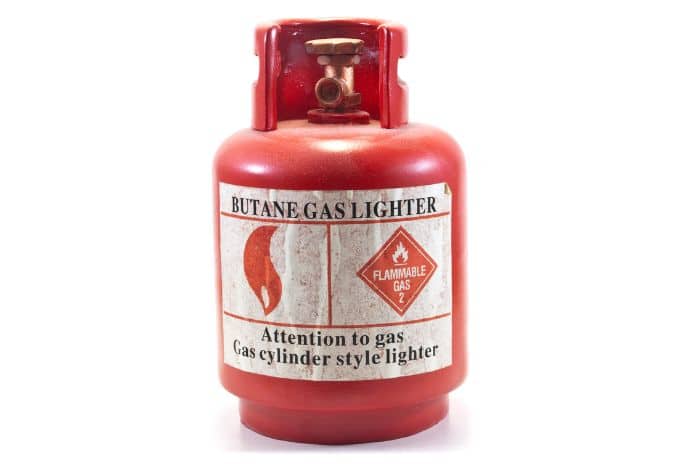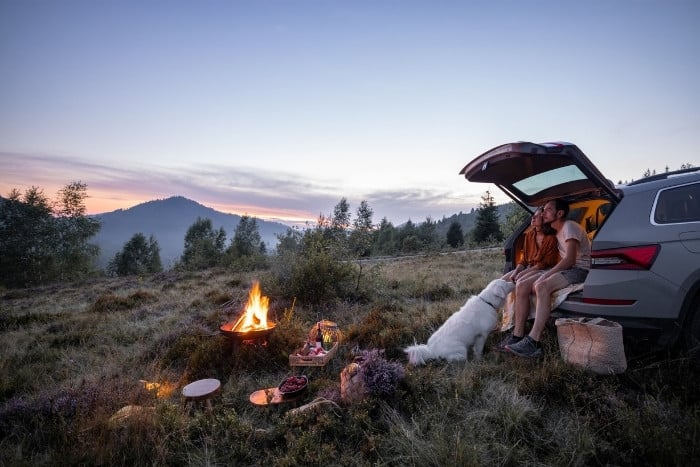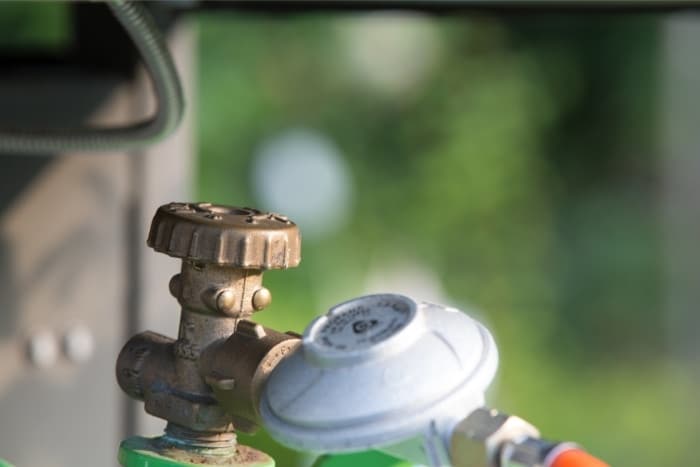You’re at a campground and need to know where to store your camping gas canisters. On the other hand, you could’ve just returned from a camping trip and found a need to store your new gas canisters while you aren’t using them. No matter the reason, you need to know where and how to store your canisters.
Camping gas canisters should be stored in a cool, dry place away from electricity, food, and flame. They should never be exposed to extreme heat or freezing temperatures. Store them in an upright position off the ground. Lock them away or put them out of reach of kids and pets. Check the seal often.
These tips will keep your containers in pristine condition. Read on for more detailed information on how to safely store your camping gas canisters!
How to Store Camping Gas Canisters?
Having gas canisters is an essential part of camping. They can make cooking easier than striking up a fire with dry tinder that you have to gather in the woods.
Here are a few quick safety tips to help you properly store your camping gas canisters.
1. Keep Away from Heat
No matter what fuel is stored in your gas canisters, keeping it away from heat is key to remaining safe.
In particular, butane is combustible if the temperatures get too high. Store it at room temperature, usually between 50F and 80F.
Never let the temperature surpass 100F.
When there is no avoiding excessive heat at your campsite, do what you can to keep your gas containers as cool as possible.
You might be able to put them in a small dish of water for a short time. Leaving them in too long can lead to rust and damage, so be cautious.

2. Stay Out of the Sun
This tip for storing camping gas containers is closely related to the last one. Leaving containers in the sun can drastically increase the temperature of the fuel inside.
Depending on the type of gas you are storing, they could be prone to explode if the temperature gets too high. Keep them in a dark and cool place instead.
A few ideas to help you keep them out of the sun include:
- Placing them around the edges of your campsite
- Throwing a tarp over them
- Covering them with some brush
Bring something with you to wrap around your canisters to keep them as cool as possible.
3. Avoid Freezing Temperatures
Not all types of gas are incompatible with cold weather, but some are. Freezing can be just as problematic for fuel as excessive heat.
If you know that you are planning your camping trip for cold weather, carefully consider the type of fuel you bring.
Propane and kerosene both hold up better under freezing temperatures than butane does.
Camping gasses have a harder time burning in the cold because it causes a pressure drop. This drop will make it impossible for you to get a fire lit.
Instead, opting for liquid fuels tends to be the better option if you’ll be camping in chillier weather.
4. No Gas Near Electrical
Unless you are primitive camping, chances are you will have some form of electricity at your campsite.
You might use it to charge your phone or power a few outdoor lights. Remember that you don’t want your camping gas canisters to get too hot.
Keeping them near a light source, particularly with a traditional bulb, can transfer some of the heat to your canisters.
Avoid allowing containers to heat up and spark an unmanageable campsite fire.
5. Lock Them Up (If You Have Kids)
Chances are that you don’t need to be told that your kids shouldn’t be around your camping gas canisters.
If you want to store them at home, keeping them on an upper shelf or locked in your storage shed is a great option.
However, you may run into more issues at the campground because there are fewer places to store them where little hands can’t reach.
Depending on the temperature, you can store them in the locked confines of your trunk.
Remember that it will be warmer inside the vehicle than outside, particularly if you are parked in the sun.
Be mindful of how hot you allow the canisters to get, and never let them exceed 100F.
When storing them in the car, you might want to wrap them in a damp towel or place them safely inside a cooler.
Keep them as cool as possible if the temperature inside your car is soaring. You can also use sun visors to reflect some harsh sun rays, keeping it cooler inside.
If storing them in the car isn’t an option, you still need to do your part to keep kids back from the containers.
Instead, store them in the tent and keep them zipped shut during the day to discourage curious minds from playing with your gas canisters.
6. No Pets
Much like you would keep your gas containers away from the prying hands of your children, you also need to keep them away from pets.
By keeping them in your car or tent where your pets are not free to roam, you are protecting them from interacting with harsh fuels.

7. Keep Canisters in Good Condition
You must find a way to store your camping gas containers in a way that does not jeopardize their integrity.
Never place them somewhere that they can fall from a great height, resulting in dents and dings.
Keep them away from sharp objects that can puncture the exterior of the container.
If it appears that there is any damage at all to your gas containers, it is time to dispose of them properly and replace them.
Sometimes retailers where you bought the gas canister from will accept returns and properly recycle them for you.
For campers storing their containers in backpacks or trunks, wrap each one in a thick cloth first.
This will provide a buffer for sharp objects such as rocks and other items in the pack that may dig into the container.
8. Avoid Smoking
While keeping your gas containers from being in the heat is crucial, you also should avoid having an open flame near them.
Smoking is one activity you should do far away from gas unless you happen to be in a very well-ventilated area.
If not, you should be sure to walk far away from the campsite if you want to light up.
9. Keep Away from Open Flames
You know just how hot it can get sitting around the campfire. It can feel good on a chilly evening, but your gas containers may not be able to handle it.
They can get too hot, leading them to spring small leaks that are invisible to the naked eye.
These leaks can make their way to your open flame and lead to massive fireballs that are hard to control or put out.
On a related note, you also want to keep your gas containers away from all combustible or fire-starting materials.
If you keep smaller canisters in your backpack for long hikes, store flammable materials somewhere far away to prevent sparks and, ultimately, fires.
10. Store Them Off the Ground
When you’re at home and need to store your camping gas canisters until the next trek into the great outdoors, carefully consider where you can store them.
It is best to keep them off the ground, but you don’t want to store them so high up that they risk falling with one wrong move.
Keeping them off the floor prevents them from being knocked over easily, particularly by small children or curious pets.
If they get knocked over, inspect them quickly for any dents or cracks that could lead to problematic leaks.
Another benefit to keeping them off the ground is that they are less likely to be exposed to water.
Water will tend to pool on the lowest levels first when you leak. This will help prevent your containers from becoming rusty and damaged.
At the campground, put it on top of your cooler or a small table to keep it off the ground.
11. Monitor Humidity Levels
Water on the ground isn’t the only moisture you need to be concerned with when it comes to storage.
Humidity can also impact the long-term safety of your gas containers.
Too much humidity can also lead to rust, compromising the safety of the container and leading to leaks.
12. Double Check the Seal
When it comes to storing gas containers, there is no such thing as being too safe. Always double and triple-check that your containers are tightly sealed.
Do this before you pack them in the car, when you arrive at the campsite, after every use, and again before you store them away in the basement or storage unit.
It never hurts to check that they are still tightly sealed.

13. Store Containers Upright
Depending on the gas canister you are using, you might want to ensure that you always place it upright.
Laying down certain types of containers, such as those with a pressure relief valve, can mess with the operation of the container.
Whenever possible, ensure that each container stands up in the trunk, backpack, or just around the campsite.
14. Avoid Plastic and Glass
If you start storing your gas in a container other than what it originally was purchased in, make sure you are choosing a safe material.
Plastics are never safe to use with fuel because the gas will eat away until they form a steady leak.
They’ll be eaten away from the inside out, leaving plastic residue at the bottom of the container.
This buildup of melted plastic can clog your stove, leading to more problems and hassle than it’s worth.
Glass may seem like a great option because it won’t be as easily affected by the fuel. Unlike plastic, glass can hold up well to exposure to these gases.
However, it is extremely easy to break a glass container while you are camping or if it gets knocked over in storage.
As a result, you should avoid glass storage containers as well.
15. Keep Gas Containers Away from Food
It might go without saying, but you should always store your gas containers far away from your food sources.
This means they should be kept away from kitchen areas, out of coolers that store your food, and in a separate part of your backpack away from snacks and water.
If your containers were to leak, they would contaminate your food.
You might not notice it immediately, but eating these contaminated foods can lead to major sickness and health concerns.
Not to mention that ruined food might leave you hungry and force you to cut your camping trip a bit shorter than you had planned.
Save yourself money on medical bills and groceries by keeping your camping gas containers far away from the food.
16. Pay Attention to Ventilation
There is always the possibility that a gas container will leak if it is kept in storage for a long time between your camping trips, is knocked over, or develops rust.
Be mindful of how much ventilation your storage place has.
If there isn’t enough fresh air and a leak occurs, you might become extremely ill when you venture into your storage shed, garage, or basement.
You might not even notice the gas leak until it is too late because they can be very difficult to smell, depending on the type of fuel they contain.
When you suspect that a gas container is leaking but can’t smell it, you may want to take it outside immediately and perform a bubble test.
You can also monitor whether the gas container leaks by taking its weight routinely.
A lighter weight without use is a sign that your container has sprung a leak somewhere and should be replaced.
Final Thoughts
Storing your camping gas containers properly is essential to maintain your safety at home and while camping.
The first thing you do when you get to a campsite or get home is to find a safe place to store them.
This can prevent tragic accidents and keep you much safer all around. Look for a cool, dry place where you can store your canisters right away.
